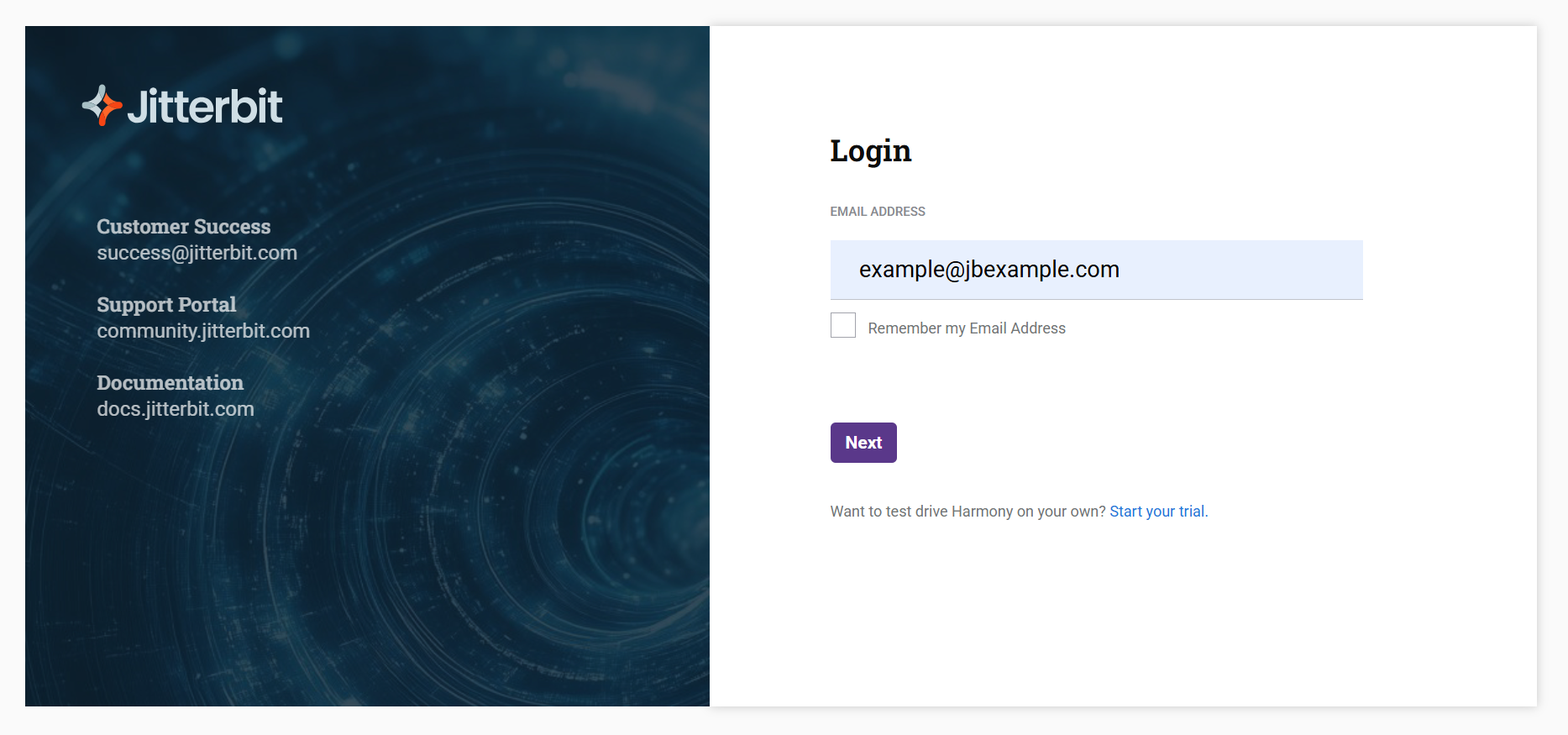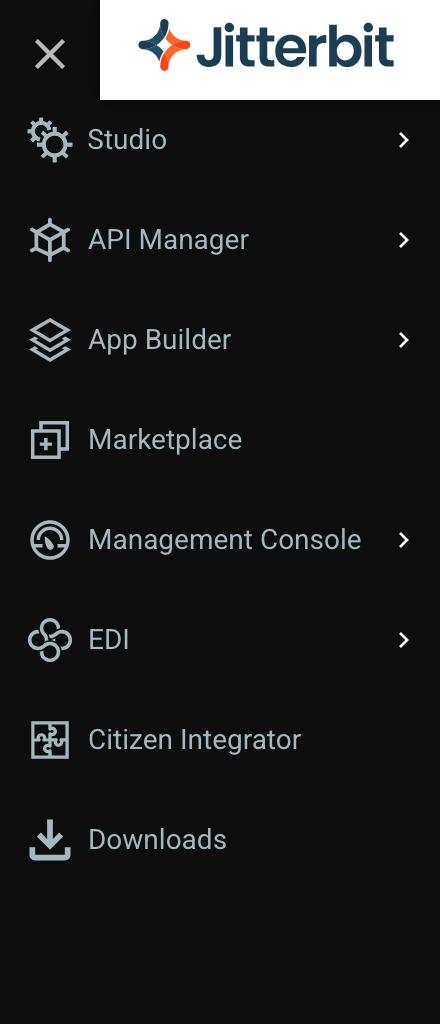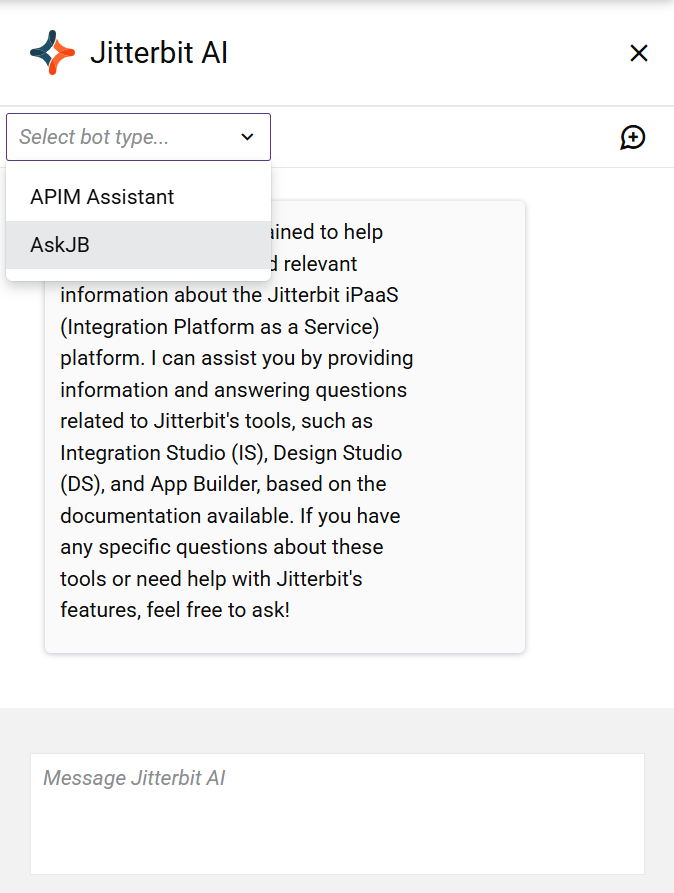Jitterbit Harmony portal
Introduction
The Harmony portal is Jitterbit's web-based interface where you access Harmony web applications, including Studio, API Manager, App Builder, EDI, Marketplace, and Management Console. You can also download other Harmony applications and components from the Harmony portal that you then install locally, including private agents, Design Studio, App Builder, and Cloud Data Loader.
The Harmony portal is accessible at https://login.jitterbit.com.
After logging in, the Harmony portal landing page is displayed. This page provides access to web-based Harmony applications, shows organization statistics, and provides links to support, learning, training, and documentation. As you navigate between the web-based Harmony applications, common elements of the Harmony portal are accessible via the header along the top of the page. Of note, these include accessing your account, where you can update your information and change your default organization, as well as changing your password.
This page describes the elements of the Harmony portal login page, the Harmony portal landing page, and the Harmony portal header.
Prerequisites
You can access Harmony portal web applications with the latest versions of these supported browsers:
- Google Chrome
- Microsoft Edge (Windows only)
- Mozilla Firefox
- Apple Safari (macOS only)
To communicate with the Harmony cloud platform, JavaScript must be enabled, and outbound port 443 (HTTPS) must be open.
Harmony portal login page
The Login page is where you log in to the Harmony portal. The steps for logging in vary from those shown below depending on if your organization and account are configured to use single sign-on or two-factor authentication (TFA).
To log in using Harmony account credentials in a non-TFA organization, follow these steps:
-
Navigate to the Harmony portal at https://login.jitterbit.com.
-
On the Login screen, enter your Jitterbit Harmony username in the form of an email address, then click Next:

-
Enter your password, then click Log in:

Tip
To reset your password, click the link I forgot my password. You will receive an email with instructions for resetting your password.
After 5 failed login attempts using Harmony account credentials, you will be locked out of your account for 30 minutes. You will be notified by email if the reason for a failed login is due to account lockout.
When a user is locked out, their status in the Management Console > User Management page in the Harmony Users tab is Inactive.
To clear the lockout, wait 30 minutes before trying to log in again with your existing password, or reset your password using the I forgot my password link.
Passwords cannot be reused. If a password change fails for any reason, including if the password has been used before, a generic error message is returned for security reasons.
Harmony portal landing page
The Harmony portal landing page provides access to web-based Harmony applications, shows organization statistics, and provides links to support, learning, training, and documentation.
Harmony applications
Tiles at the top of the landing page provide access to web-based Harmony applications:

Applications load in the current browser tab. Navigation between applications or back to the Harmony portal landing page is then done through the Harmony portal header (see Harmony portal menu later on this page).
Harmony organization statistics
Information about the selected Harmony organization is displayed with a gray background. You can switch to another Harmony organization through the Harmony portal header (see Selected organization later on this page).
Your organization subscription (such as Harmony Enterprise) is shown, along with Customer Success contact information. Additional information is available at Jitterbit support.
Click the caret next to the subscription description to show statistics for the organization:

- Environments: The number of environments in the organization. Opens the Management Console Environments page.
- Projects: The number of deployed and undeployed Studio and Design Studio projects in the organization. Opens the Management Console Projects page, which lists deployed projects.
- Operations: The number of deployed Studio and Design Studio operations in the organization. Opens the Management Console Runtime Operations page, where you can search for operation logs.
- Failed Operations (Last 7 Days): The number of Studio and Design Studio operations executed in the organization within the past seven days that resulted in an error status. Opens the Management Console Runtime Operations page, preconfigured to search for operation logs with an error status.
- Private Agents: The number of private agents in the organization. Opens the Management Console Agents page.
- Agent Groups: The number of agent groups in the organization. Opens the Management Console Agents page.
- Harmony Users: The number of organization members. Opens the Management Console User Management page.
- Operations Run (Last 7 Days): The number of Studio and Design Studio operations executed in the organization within the past seven days. Opens the Management Console Runtime Operations page, where you can search for operation logs.
- API URLs: The number of API Manager APIs in Published or Published with Draft status. Opens the API Manager application.
Support, learning, training, and documentation
This section provides links to support, learning, training, and documentation:
- Getting Started Studio: A guide and introduction to project design concepts using Jitterbit's web-based project design application.
- Getting Started API Manager: Documentation on navigating and managing the APIs configured through Jitterbit's end-to-end API solution.
- Getting Started Marketplace: An overview of Jitterbit's resource to find pre-built recipes and templates for your Studio projects.
- Getting Started Management Console: Resources for administrators to manage and monitor your Jitterbit organization and integrations.
- Getting Started Design Studio: A guide to designing a project with Jitterbit's wizard-driven desktop application.
- Harmony Release Notes: A compilation of release notes describing what's new in our Harmony products.
- Support Requests: A portal for managing support cases submitted to our team of highly qualified experts.
- Jitterbit Documentation: Documentation on our Harmony products, including reference materials, how-tos, and best practices.
- Jitterbit Community: A crowd-sourced forum for questions and answers on Harmony products.
- Jitterbit University: In-depth educational courses on integration and APIs using our Harmony products.
Harmony portal header
The Harmony portal header is displayed along the top of each page accessed through the Harmony portal:

This header persists as you navigate through the web-based Harmony applications.
Harmony portal menu
The Harmony portal menu is a bar on the left of the page. Until you hover on it, it is in compact form, and shows icons for each Harmony application. When you hover on it, it expands to show application names:
| Compact | Expanded |
|---|---|
 |
 |
-
Studio: A web-based project design application, offering hundreds of connectors to interact with various data resources.
-
API Manager: An API management web interface where you can create and publish developer-friendly APIs and perform full API lifecycle management tasks.
-
App Builder: A low-code application development platform that enables you to build end-to-end, enterprise-grade applications.
-
Marketplace: A resource for searching and retrieving Studio integration recipes and process templates to help you quickly create new Studio projects.
-
Management Console: Jitterbit's web console where you can manage your integration projects and perform administrative functions related to your organization.
-
EDI: A web application for connecting to and managing EDI trading partners and the transactions made with them.
-
Citizen Integrator: A web application for customizing and deploying Design Studio integrations using pre-built Citizen Integrator recipes.
-
Downloads: A page where you can download on-premises Harmony applications and tools, such as Design Studio, private agents, and private API gateways.
Click the expand icon next to an application name to see application page links. Click a link to visit the page. Click the collapse icon to close the application's page list. To keep the menu expanded, click the top left icon. Click the icon to return the menu to compact form.
The Jitterbit logo next to the Harmony portal menu is present on every page and clicking it returns you to the Harmony portal landing page. Once you are within a Harmony app, the Harmony app logo and name appear next to the Jitterbit logo and clicking the Harmony app logo returns you to the landing page for the respective Harmony app:

My account
To access your account settings, click the caret next to your name and select My Account:

This opens a new page where you can update your information or change your default organization:

The following fields are shown:
-
In the Personal information section:
-
First name: This is used in the welcome message within the Harmony portal.
-
Last name: (Optional) Your last name.
-
-
In the Contact information section:
-
Contact: Your contact telephone number.
Note
This is stored only for your information and is not shared with other Jitterbit users.
-
Email: This is the email address that you used to register your Harmony account. It cannot be changed through this section. This field is used when you log in to the Harmony portal, as well as for others to invite you to other Harmony organizations. If you want to update your email address, please contact support.
-
-
In the Platform settings section:
Default organization: (Optional, if you belong to more than one organization.) Click to open the menu, then choose which organization to be selected by default when you log in.
Note
If you are logging in after being automatically logged out due to inactivity, you will be returned to the same screen and organization you were accessing when you were logged out. If you had switched organizations after logging in, this may be different from your default organization.
After making any updates on this page, click the Save button.
Change password
To change your password while logged in, click the caret next to your name and select Change Password:

This opens a new page where you can update your password:

Provide your current password and a new password meeting the stated security requirements, then click the Save button.
On saving the new password, you remain logged in only in the current browser application or browser mode (if using a private browser mode such as Google Chrome's incognito mode). You are redirected to the Harmony portal landing page in all open windows and tabs in the same browser application or browser mode where you changed the password.
If you were logged in using any other browser applications or browser modes, you are automatically logged out. Enter the new password to log back in.
What's new
To see a summary of the latest release highlights, click the caret next to your name and select What's New:

This opens a separate tab on the Jitterbit Documentation site summarizing new release features, enhancements, and changes. Detailed release notes are available under Release notes.
Log out
You can manually log out of the Harmony portal. If you don't log out, the Harmony portal will automatically log you out after 4 hours of inactivity. The 4 hours of inactivity is based on the user data stored in your browser's local storage.
To log out, click the caret next to your name and select Logout:

You will be returned to the Harmony login page.
If you are logged out due to inactivity, the Harmony portal login page is displayed with a URL that identifies the location you were last accessing. When you log in again from that screen, you will be returned to the same screen and organization you were accessing when you were logged out.
Selected organization
To switch the active organization within the Harmony portal, click the organization dropdown and select another organization:

You can access multiple organizations simultaneously using different browsers, browser tabs, or windows.
Help
The Help link in the top right opens a menu of links:
Jitterbit AI
A Jitterbit AI icon on the far right opens a chatbot panel on the right side of the screen:

By default, the chatbot loads AskJB AI, an AI chatbot that helps you get answers about using Jitterbit's products by generating answers sourced from the Jitterbit Documentation site.
Organizations whose license includes the APIM AI Assistant, an AI chatbot that helps you create and maintain assets in API Manager, have a menu to switch between AI bot types while accessing API Manager or Studio.
Important
The APIM AI Assistant is hidden unless your Harmony license includes the APIM AI Assistant option. Contact your Customer Success Manager (CSM) to have it added to your Harmony license.

Release schedule and release notes
The Harmony portal and its applications are automatically updated to the latest version following the Harmony release schedule.
In the Harmony release notes, the Harmony portal is considered part of the Cloud platform and applications category. Individual release notes for each web application are listed under respective headings for those applications. Release notes may also be listed under a Harmony portal category for other Harmony portal updates that are not limited to a specific web application.